Norroy and Ulster King of Arms
 The arms of office of the Norroy and Ulster King of Arms | |
| Heraldic tradition | British |
|---|---|
| Jurisdiction | England north of the river Trent and Northern Ireland |
| Governing body | College of Arms |
Norroy and Ulster King of Arms is the provincial King of Arms at the College of Arms with jurisdiction over England north of the Trent and Northern Ireland. The two offices of Norroy and Ulster were formerly separate. Norroy King of Arms is the older office, there being a reference as early as 1276 to a "King of Heralds beyond the Trent in the North". The name Norroy is derived from the Old French nort roy meaning 'north king'.[1][2] The office of Ulster Principal King of Arms for All-Ireland was established in 1552 by King Edward VI to replace the older post of Ireland King of Arms, which had lapsed in 1487.
Ulster King of Arms was not part of the College of Arms and did not fall under the jurisdiction of the Earl Marshal, being the heraldic authority for the Kingdom of Ireland (the jurisdiction of the College of Arms being the Kingdom of England and Lord Lyon's Office that of the Kingdom of Scotland).
Ulster was Registrar and King of Arms of the Order of St Patrick. Norroy and Ulster King of Arms now holds this position,[citation needed] though no new knights of that Order have been created since 1936, and the last surviving knight died in 1974. Heraldic matters in the Republic of Ireland are now handled by the office of the Chief Herald of Ireland (a part of the Genealogical Office in the National Library).
The arms of the new office of Norroy and Ulster King of Arms were devised in 1980 based on elements from the arms of the two former offices. They are blazoned: Quarterly Argent and Or a Cross Gules on a Chief per pale Azure and Gules a Lion passant guardant Or crowned with an open Crown between a Fleur-de-lis and a Harp Or.
The current Norroy and Ulster King of Arms is Clive Cheesman who was appointed to the office on 14 November 2024.[3]
Norroy Kings of Arms until 1943
[edit]

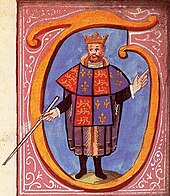


| Arms | Name | Dates of office | Notes | Ref |
|---|---|---|---|---|

|
Peter de Horbury | (1276) | ||
| Andrew | (1338) | |||
| John Othelake | 1386–1399 | |||
| Office holders referred to as Lancaster King of Arms. This title was used for the King of Arms of the northern province in the reigns of Henry IV, V and VI, instead of Norroy. | ||||
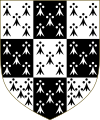
|
Richard Bruges | 1399–1426 | ||
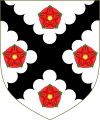
|
John Ashwell | 1426–1436 | ||

|
William Boys | 1436–1447 | ||

|
William Tyndale | 1447–1464 | ||
| The title reverted to Norroy King of Arms. | ||||

|
Thomas Holme | 1464–1477 | ||

|
John Writhe | 1477–1478 | ||

|
John Moore | 1478–1493 | ||

|
Roger Machado | 1493-1493 | ||

|
Christopher Carlill | 1493–1510 | ||

|
Thomas Benolt | 1510-1510 | ||

|
John Yonge | 1510–1516 | ||

|
Thomas Wall | 1516–1522 | ||
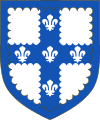
|
John Joyner | 1522-1522 | ||
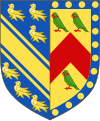
|
Thomas Tonge | 1522–1534 | ||

|
Thomas Hawley | 1534–1536 | ||

|
Sir Christopher Barker | 1536 | ||

|
William Fellows | 1536–1546 | ||

|
Gilbert Dethick | 1546–1550 | ||
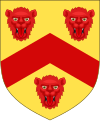
|
William Harvey | 1550–1557 | ||

|
Lawrence Dalton | 1557–1562 | ||
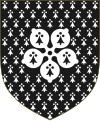
|
William Flower | 1562–1588 | ||
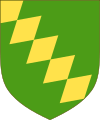
|
Edmund Knight | 1592–1593 | ||
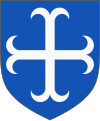
|
William Segar | 1593–1603 | Morgan Coleman had also applied for the position.[4] | |
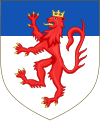
|
Sir Richard St George | 1603–1623 | ||

|
Sir John Burroughs | 1623–1634 | ||

|
Sir William le Neve | 1634–1635 | ||

|
Sir Henry St George | 1635–1644 | ||
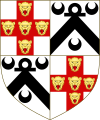
|
Sir Edward Walker | 1644–1645 | ||

|
William Ryley | 1646–1658 | ||

|
George Owen | 1658–1660 | ||

|
Sir William Dugdale | 1660–1677 | ||

|
Sir Henry St George | 1677–1680 | ||

|
Sir Thomas St George | 1680–1686 | ||

|
Sir John Dugdale | 1686–1700 | ||

|
Robert Devenish | 1700–1704 | ||

|
Peter Le Neve | 1704–1729 | ||
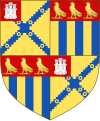
|
Stephen Leake | 1729–1741 | ||
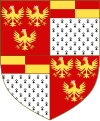
|
John Cheale | 1741–1751 | ||

|
Sir Charles Townley | 1751–1756 | ||
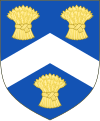
|
William Oldys | 1756–1761 | ||

|
Thomas Brown | 1761–1773 | ||
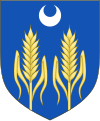
|
Ralph Bigland | 1773–1774 | ||

|
Sir Isaac Heard | 1774–1780 | ||
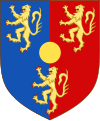
|
Peter Dore | 1780–1781 | ||
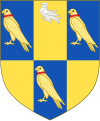
|
Thomas Lock | 1781–1784 | ||

|
George Harrison | 1784–1803 | ||

|
Ralph Bigland | 1803–1822 | ||
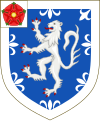
|
Edmund Lodge | 1822–1838 | ||

|
Joseph Hawker | 1838–1839 | ||

|
Francis Martin | 1839–1846 | ||

|
James Pulman | 1846–1858 | ||

|
Edward Howard-Gibbon | 1848–1849 | ||

|
Robert Laurie | 1849–1859 | ||

|
Walter Blount | 1859–1882 | ||
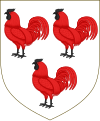
|
George Cokayne | 1882–1894 | ||
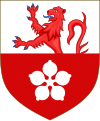
|
Sir William Weldon | 1894–1911 | ||

|
Sir Henry Burke | 1911–1919 | ||

|
Charles Athill | 1919 | ||

|
William Lindsay | 1919–1922 | ||

|
Gordon Lee | 1922–1926 | ||

|
Sir Arthur Cochrane | 1926–1928 | ||
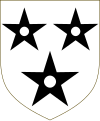
|
Sir Gerald Wollaston | 1928–1930 | ||

|
Sir Algar Howard | 1931–1943 | ||
| Title combined with Ulster King of Arms | ||||
Ulster Kings of Arms until 1943
[edit]
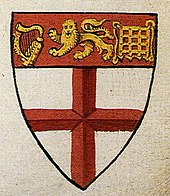
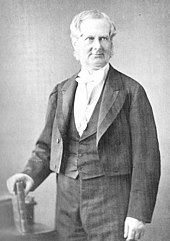

| Arms | Name | Dates of office | Notes | Ref |
|---|---|---|---|---|
| Title formerly Ireland King of Arms | ||||

|
Bartholomew W. Butler | 1552–1566 | ||

|
Nicholas Narbon | 1566–1588 | ||

|
Christopher Ussher | 1566–1588 | ||
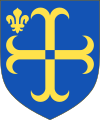
|
Daniel Molyneux | 1597–1629 | ||
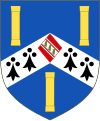
|
Daniel Molyneux and Adam Ussher | 1629–1633 | ||

|
Thomas Preston, 1st Viscount Tara | 1633–1655 | ||

|
Sir Richard Carney | 1655–1660 | ||

|
Sir Richard St George | 1660–1683 | ||

|
Sir Richard Carney and George Wallis | 1683–1698 | ||
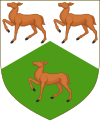
|
William Hawkins | 1698–1722 | ||

|
William Hawkins and John Hawkins | 1722–1759 | ||

|
James McCulloch | 1759–1765 | ||

|
William Hawkins | 1765–1787 | Knighted 17 March 1783 | |

|
Gerald Fortescue | 1787–1788 | ||

|
Rear Admiral Sir Chichester Fortescue | 1788–1820 | ||

|
Sir William Betham | 1820–1853 | ||

|
Sir Bernard Burke | 1853–1892 | ||

|
Sir Arthur Vicars | 1893–1908 | ||

|
Sir Nevile Rodwell Wilkinson | 1908–1940 | ||
| Vacant, duties performed by Thomas Ulick Sadleir (Deputy Ulster) | ||||
| Duties in the Republic of Ireland taken up by the Chief Herald of Ireland | ||||
Norroy and Ulster Kings of Arms from 1943
[edit]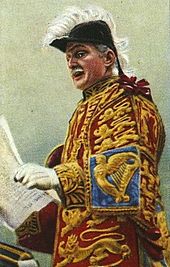

| Arms | Name | Dates of office | Notes | Ref |
|---|---|---|---|---|

|
Sir Algar Howard | 1943–1944 | Howard was descended from the Dukes of Norfolk; he was born in Thornbury Castle, where he lived for many years.[5] Educated at King's College London,[6] he was later admitted to the Inner Temple as a barrister. His first appointment at the College was in May 1911 as Fitzalan Pursuivant Extraordinary and he attended the Prince of Wales' investiture that year.[6] He was promoted to Rouge Dragon Pursuivant that October, followed by Windsor Herald in 1919 and Norroy King of Arms in 1931, to which was added Ulster King of Arms in 1943.[6] After he resigned as Garter, he served as Extra Gentleman Usher to the Queen from 1952 till his death, aged 89, in 1970.[5][7] | [6] |

|
Sir Gerald Wollaston | 1944–1957 | A grandson of Sir Albert William Woods,[8] Wollaston was educated at Harrow School and then Trinity College, Cambridge, where he graduated in 1893 with a law degree.[9][10] He was called to the Bar in 1899, but joined the College three years later as Fitzalan Pursuivant Extraordinary for the coronation of Edward VII. Appointments as Bluemantle Pursuivant (1906), Richmond Herald (1919), and Norroy King of Arms (1928) followed.[9] Having served as Henry Farnham Burke's deputy for a year,[9] he succeeded him as Garter and oversaw the coronation of George VI; his experience and knowledge of ceremonial proved useful in assisting the young Earl Marshal. Earlier in his career, he was often called on to counsel in peerage cases.[10] A "most painstaking and skilled herald with special bent to ceremonial", he published The Court of Claims in 1902, 1910 and 1936.[9] After his Gartership, he served as Norroy and Ulster until his death in 1957.[10] | [9] |
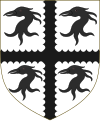
|
Aubrey Toppin | 1957–1966 | ||

|
Richard Graham-Vivian | 1966–1971 | ||

|
Sir Walter Verco | 1971–1980 | ||

|
John Brooke-Little | 1980–1995 | Brooke-Little was educated at Clayesmore School and New College, Oxford, where his interest in heraldry grew and his friends included the future Garter, Colin Cole. He joined the Earl Marshal's staff in 1952 and was a Gold Stick Officer at the coronation in 1953. Appointed Bluemantle Pursuivant in 1956 and Richmond Herald in 1967, Brooke-Little also served as Registrar at the College (1974–82), Norroy and Ulster King of Arms and Registrar of the Order of St Patrick (1980–85) and director of the Heralds' Museum from 1991 until his retirement. He founded the Heraldry Society in 1947 and was its Chairman for fifty years, after which he was its President; he edited its journal, The Coat of Arms, until 2004. His published work included updated editions of Boutell's Heraldry and Fox-Davies's Complete Guide to Heraldry. According to the Telegraph, he was the "brightest and ablest herald of his generation", but did not attain Gartership partly due to his "chaotic working practices". He died in 2006. | [11][12][13] |

|
Hubert Chesshyre | 1995–1997 | After attending Trinity College, Cambridge, and Christ Church, Oxford, and graduating from both universities, Chesshyre became Rouge Croix Pursuivant in 1970, before serving as Chester Herald between 1978 and 1995 and Honorary Genealogist to the Royal Victorian Order from 1987 to 2010. He has been a member of the Westminster Abbey Architectural Advisory Panel and the Heraldry Society's Council. Along with Thomas Woodcock, he co-authored the Dictionary of British Arms: Medieval Armorial, volume 1. | [14][15] |
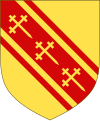
|
Thomas Woodcock | 1997–2010 | Woodcock was educated at Durham University and Darwin College, Cambridge. He was called to the Bar in 1975, but started work as a research assistant to Sir Anthony Wagner that year. He was appointed Rouge Croix in 1978, Somerset in 1982 and Norroy and Ulster in 1997. He has co-authored a number of works on heraldry, including The Oxford Guide to Heraldry (1988) and all four volumes of Dictionary of British Arms: Medieval Ordinary (1992–2014).[16] | [17][18] |

|
Patric Dickinson | 2010 | Dickinson was educated at Exeter College, Oxford, and was President of the Oxford Union in 1972. A research assistant at the College of Arms since 1968, his first heraldic appointment was ten years later, when he became Rouge Dragon Pursuivant. Promotions to Richmond Herald (1989) and Norroy and Ulster King of Arms (2010) followed, before he became Clarenceux. Having served as the College's Treasurer since 1995, Dickinson was also the Earl Marshal's Secretary from 1996 to 2012 and has been President of the Society of Genealogists since 2005. | [19][20] |
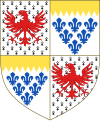
|
Sir Henry Paston-Bedingfeld | 2010–2014 | ||

|
Timothy Duke | 2014–2021 | ||
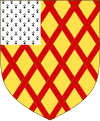
|
Robert Noel | 2021–2024 | ||

|
Clive Cheesman | 2024-present | [21] |
See also
[edit]References
[edit]Citations
- ^ "Norroy". Collins English Dictionary. Retrieved 2 July 2023.
Word origin C15: Old French nor north + roy king
- ^ Burke, Bernard, Sir (1884). "The general armory of England, Scotland, Ireland, and Wales; comprising a registry of armorial bearings from the earliest to the present time". London : Harrison & sons (Internet Archive). Retrieved 2 July 2023.
"Norroy King of Arms", the most ancient of the heraldic sovereigns in England possesses as his province, England north of the Trent. He is the North King — "Norroy." The English Heralds bear the designation of "Windsor", "Chester", "Somerset", "Lancaster", "York" and "Richmond" the Pursuivants, are known by the names of "Rouge Dragon", "Rouge Croix", "Bluemantle" and "Portcullis." The date of the creation of the historic and dignified office of Garter King of Arms may be fixed with certainty to have been between May and September, 1417. The first Garter was William Bruges, originally styled "Guyenne King of Arms" and subsequently "Garteir Roy d'Armes des Anglois." By the constitution of King Henry VIII., it was provided that Garter should be Sovereign within the College of Arms above all the other officers...
{{cite web}}: CS1 maint: multiple names: authors list (link) - ^ "New Appointments". College of Arms. Retrieved 15 November 2024.
- ^ Joseph B. R. Massey (2021). "The Saxon Connection: St Margaret of Scotland, Morgan Colman's Genealogies, and James VI & I's Anglo-Scottish Union Project". Royal Studies Journal. 8 (1): 109. Retrieved 22 June 2021.
- ^ a b "Sir Algar Howard", The Times, 16 February 1970, p. 10
- ^ a b c d Godfrey and Wagner 1963, pp. 72–73
- ^ "Howard, Sir Algar (Henry Stafford)", Who Was Who [online edition April 2014] (Oxford University Press)
- ^ Godfrey and Wagner 1963, p. 69
- ^ a b c d e Godfrey and Wagner 1963, pp. 71-72
- ^ a b c "Sir Gerald Woods Wollaston", The Times, 5 March 1957, p. 10
- ^ London Gazette, 27 June 1995 (issue 54085), p. 8847
- ^ "John Brooke-Little", The Telegraph, 16 February 2006
- ^ "Brooke-Little, John Philip Brooke", Who Was Who, A & C Black, an imprint of Bloomsbury Publishing plc, 1920–2015; online edn, Oxford University Press, 2014; online edn, April 2014
- ^ Supplement to the London Gazette, 2 May 1997 (issue 54755), p. 5289
- ^ "Chesshyre, (David) Hubert (Boothby)", Who's Who 2014, A & C Black, an imprint of Bloomsbury Publishing plc, 2014; online edn, Oxford University Press, 2014; online edn, Nov 2014
- ^ "Woodcock, Thomas", Who's Who, 2015 [online edition October 2014] (Oxford University Press)
- ^ Thomas Woodcock, "St George, Sir Henry (1581–1644)", Oxford Dictionary of National Biography, Oxford University Press, 2004; online edn, Jan 2008
- ^ Godfrey and Wagner, pp. 55-56, 90
- ^ "No. 59536". The London Gazette. 6 September 2010. p. 17131.
- ^ "Dickinson, Patric Laurence", Who's Who 2014, A & C Black, an imprint of Bloomsbury Publishing plc, 2014; online edn, Oxford University Press, 2014; online edn, Nov 2014
- ^ "No. 64573". The London Gazette. 19 November 2024. p. 23518.
Bibliography
- The College of Arms, Queen Victoria Street : being the sixteenth and final monograph of the London Survey Committee, Walter H. Godfrey, assisted by Sir Anthony Wagner, with a complete list of the officers of arms, prepared by H. Stanford London, (London, 1963)
- A History of the College of Arms &c, Mark Noble, (London, 1804)
- List of Ulster Kings of Arms

